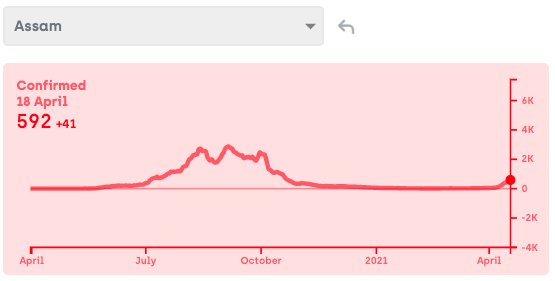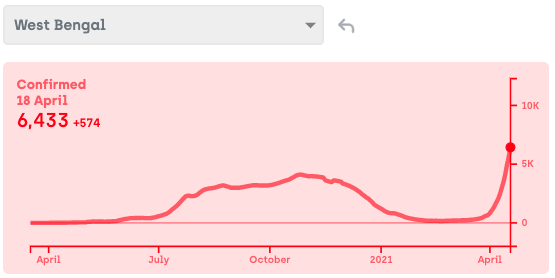
Union home minister and senior BJP leader Amit Shah during a road show for party candidates in Islampur, April 13, 2021. Photo: Twitter/@AmitShah/PTI
Bengaluru/New Delhi: Union home minister Amit Shah has said we shouldn’t blame the elections in West Bengal, Tamil Nadu, Kerala, Assam and Puducherry for the spike in COVID-19 cases there.
Elections are important and must be held with the right precautions and safeguards. The real problems lie in organising large rallies and holding road-shows instead of televising addresses, organising smaller live-streamed meetings, etc.
Last week, the Economic Times ran four charts which showed a sharp spike in COVID cases in the four states and one Union Territory where elections took place. The West Bengal election still has three phases to go. Of course, cases are rising sharply elsewhere too, a fact that the home minister has latched on to.
Shah’s argument is problematic because it implies that it is okay to organise large, crowded events at a time when India’s case load could make the country the world’s ‘Vishwaguru’ of COVID-19 infections. He told the Indian Express that he was “concerned” for both Maharashtra and West Bengal, but that the former has still been reporting a lot more cases.
Update, 9:48 am, April 20: On April 20, at the conclusion of the sixth phase of polling in Bengal, the BJP said it wouldn’t hold any rallies or meetings of more than 500 people in the state.
However, Shah makes three mistakes.
1. You don’t need data to make certain points
Amit Shah and the Bharatiya Janata Party government more broadly have displayed a tendency to insist on data, and if that data doesn’t exist, to say that a particular event or phenomenon didn’t happen.
For statisticians to establish a causal link between the people who participated in election rallies and the growth in COVID infections, they would have to plot the current growth trend, potential deviations from the trend due to the rallies, attribute the deviation to the rallies and eliminate the presence of similar deviations in the data of non-poll-bound states.
These calculations would in turn need us to know the variants that are spreading in different districts and their transmission characteristics. Alternatively, officials could trace down and then track every individual who participated in the rallies – a very laborious and fruitless exercise.
However, not being able to do either of these things wouldn’t invalidate the rather obvious argument that the rallies and meetings held offered more opportunities than usual for the virus to spread.
There is already a hint of a correlation in the fact that West Bengal is adding active cases much faster than Maharashtra or Delhi have since April 1.
Every day, a certain number of people contract the disease while a certain number recover from it. If more people test positive than are cured, this means active cases are rising. So when Amit Shah says elections don’t matter, he needs to answer why the number of daily new active COVID-19 cases in Bengal on April 18 (8,419) is 1,040% higher than it was on April 1, while Delhi and Maharashtra, which are notorious hotspots, show a much slower pace of increase – 209% and 118% respectively.
That is, the number of people in West Bengal who are COVID-positive on a daily basis is rising nearly five-times faster than Delhi and nearly 10-times faster than Maharashtra.
However, efforts to answer this question are bound to be complicated by the variants circulating in these populations, quality of healthcare, testing rate and the outbreaks in these states being out of phase, all of which affect the number of daily new infections and daily recoveries.
So we need more data and more work to conclusively prove a causative link exists between election rallies and West Bengal’s active case load. But the odds of this link existing are self-evidently high.
2. Infection clusters drive the epidemic
Maintain physical distances, wear masks and wash your hands – these are the principal guidelines for any individual today. Not following them, especially not following them en masse, is automatically a recipe for disaster. It may even be the recipe for disaster.
Both scientific studies and news reports have noted that clusters of infections have played a significant role in seeding large outbreaks. South Korea’s large spike in the early days of the pandemic last year was attributed in part to the carelessness of a single person. In a meta-analysis of 65 studies, researchers found that last year, there had been 108 cluster infection events in 13 regions around the world. Of them, 67% occurred in China. According to a report published by The Lancet COVID-19 Commission’s India task force:
“The second wave has been more geographically clustered so far. The number of districts comprising the top 50% has dropped from over 40 at the time of the last peak, to less than 20 currently, indicating a much more concentrated epidemic. In fact during the first surge over August and September, the number of districts for the top 75% of cases was 60-100, while it has been around 20-40 districts during this surge.”
More recently, the Times of India reported on April 7 that Mumbai doctors say the “rapid spread of the infection in much bigger groups and failure to prevent entire families from getting infected despite isolating index cases are emerging as key factors in the ongoing transmission.”
In fact, the Kumbh Mela on April 12 itself defeats Amit Shah’s point. The mela was attended by nearly 30 lakh people from around India, and within a week of getting underway, sent the number of cases in Haridwar, the venue, soaring by a disproportionate extent. Devotees at the mela have also tested positive after returning to their origin cities.
In light of these issues, Shah told Times Now that this is why the Centre appealed to the festival’s organisers to make its attendance “symbolic”. Setting aside the delayed fuse, the Centre’s decision is an admission that it knows large, congested gatherings – even if held out in the open – are a bad idea. We shouldn’t have to wait for more data to act.
3. No state needs rallies right now
Consider the following graphs showing seven-day moving averages of the case load (from covid19india.org) in both poll-bound and non-poll-bound states:












Both poll-bound and non-poll-bound states either show an exponentially rising case load or seem to be on the cusp of it. Why are non-poll-bound states reporting exponential growth if they are not organising rallies, meetings, etc.? It’s because of a hidden confounding factor: the population of susceptible people. As long as there are more susceptible people in a given population, both opportunities for more cases and faster spread will exist.
The susceptible population has been modified between 2020 and 2021 thanks to our updated knowledge of new novel coronavirus variants and the possibility of being infected more than once with COVID-19.
In the absence of COVID-appropriate behaviour and in the presence of novel variants and potential for reinfection, there will continue to be more cases irrespective of the mode of transmission – large gatherings, family functions, travelling, going shopping in the market, etc. A rally will only ‘transform’ susceptible people into infected people faster, unflattening the curve.
Given the tremendous nationwide shortage of hospital beds, medical oxygen, vaccines and drugs, the Indian government has flopped on this front. In fact, senior government officials and ministers were in a triumphalist mood barely two months ago, saying India’s epidemic had entered its “endgame” and that Modi was a “vaccine guru”. But today, it is abundantly clear that even if the new wave caught the government off-guard, the government couldn’t have been surprised about the unpreparedness of the population to deal with it. Yet it was.
Both the Central and various state governments need to quickly cut down the size of the susceptible population and improve access to and quality of hospital care for those who still need it.
It should be obvious that curtailing or cancelling elections rallies is one way to reduce the exposure of people in West Bengal to the virus.

